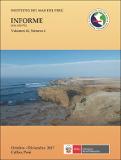Por favor, use este identificador para citar o enlazar este ítem:
https://hdl.handle.net/20.500.12958/3231Registro completo de metadatos
| Campo DC | Valor | Lengua/Idioma |
|---|---|---|
| dc.contributor.author | Tejada Cáceres, Alex | - |
| dc.contributor.author | Baldarrago, Danny | - |
| dc.contributor.author | Aragón, Beatriz | - |
| dc.contributor.author | Romucho, Yenny | - |
| dc.contributor.author | Villanueva, Javier | - |
| dc.contributor.author | Liza, Carmen | - |
| dc.contributor.editor | Instituto del Mar del Perú | - |
| dc.date.accessioned | 2018-08-16T19:08:50Z | - |
| dc.date.available | 2018-08-16T19:08:50Z | - |
| dc.date.issued | 2017 | - |
| dc.identifier.citation | Inf Inst Mar Perú 44(4), 2017, p. 529-551 | es_ES |
| dc.identifier.issn | 03787702 | - |
| dc.identifier.uri | https://hdl.handle.net/20.500.12958/3231 | - |
| dc.description.abstract | Se caracterizaron las playas de arena del litoral de las Regiones Moquegua y Tacna; las que presentaron diferencias en configuración y estado morfodinámico, predominando playas de tipo intermedia y disipativa. La macha Mesodesma donacium (Lamarck, 1818) exhibió escasa presencia en estos ambientes, registrándose un rango de tallas entre 50 y 86 de mm de longitud total (LT). El comportamiento reproductivo, indicó periodo de reposo gonadal en febrero. El muy muy Emerita analoga (Stimpson, 1857) predominó en las playas de ambas regiones, mayores abundancias se encontraron en febrero cuando se registra importante presencia de megalopas; en setiembre, se observó mayor presencia de hembras ovígeras; además, del ingreso de una nueva cohorte. La riqueza de las playas de arena está conformada por 16 especies. En términos de frecuencia de ocurrencia en la comunidad de playas las más importantes fueron Emerita analoga; Excirolana braziliensis Richardson, 1912 y Hemipodia simplex (Grube, 1857). El cangrejo carretero Ocypode gaudichaudii Milne Edwards y Lucas, 1843 presentó distribución entre uniforme, agregada y aleatoria por playa y por periodo de muestreo, lo que indicó comportamiento aleatorio de la población ante eventos naturales y antropogénicos. | es_ES |
| dc.description.abstract | ABSTRAC: The sandy beaches of the coast of the Moquegua and Tacna Regions were characterized; those that presented differences in configuration and morphodynamic state, predominating beaches of intermediate and dissipative type. The surf clam Mesodesma donacium (Lamarck, 1818) exhibited little presence in these environments, registering a size range between 50 and 86 of total length mm (TL). The reproductive behavior indicated a period of gonadal rest in February. The Pacific sand crab Emerita analoga (Stimpson, 1857) predominated on the beaches of both regions; higher abundances were found in February when there was a significant presence of megalopas; in September, a greater presence of ovigerous females was observed, in addition, the income of a new cohort. The richness of the sandy beaches is made up of 16 species. In terms of frequency of occurrence in the beach community, the most important were Emerita analoga; Excirolana braziliensis Richardson, 1912 and Hemipodia simplex (Grube, 1857). The painted ghost crab Ocypode gaudichaudii Milne Edwards and Lucas, 1843 presented uniform, aggregated and random distribution by beach and by sampling period, which indicated random behavior of the population before natural and anthropogenic events. | - |
| dc.language.iso | spa | es_ES |
| dc.publisher | Instituto del Mar del Perú | es_ES |
| dc.relation.ispartofseries | Informe IMARPE;44(4), 2017 | - |
| dc.rights | info:eu-repo/semantics/openAccess | es_ES |
| dc.rights.uri | https://creativecommons.org/licenses/by/4.0/ | es_ES |
| dc.source | Instituto del Mar del Perú - IMARPE | es_ES |
| dc.source.uri | Repositorio Digital IMARPE | es_ES |
| dc.subject | Biodiversidad marina | es_ES |
| dc.subject | Mesodesma donacium | es_ES |
| dc.subject | Emerita analoga | es_ES |
| dc.subject | Playas | es_ES |
| dc.subject | Moquegua | es_ES |
| dc.subject | Tacna | es_ES |
| dc.title | Caracterización de playas arenosas del litoral de las Regiones Moquegua y Tacna. 2015 | es_ES |
| dc.title.alternative | Characterization of sandy beaches of the littoral of the Regions Moquegua and Tacna. 2015 | es_ES |
| dc.type | info:eu-repo/semantics/article | es_ES |
| Aparece en las colecciones: | Informe vol. 44(4) 2017 | |
Ficheros en este ítem:
| Fichero | Descripción | Tamaño | Formato | |
|---|---|---|---|---|
| Informe 44(4)5.pdf | 40,83 MB | Adobe PDF |  Visualizar/Abrir |
Este ítem está sujeto a una licencia Creative Commons Licencia Creative Commons

